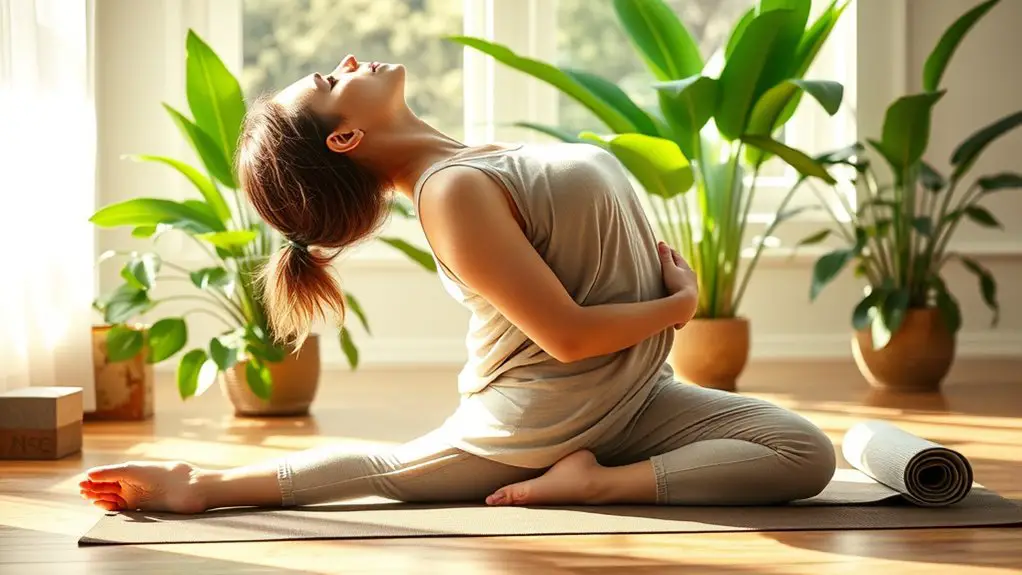Core stability is essential for long-distance cycling. It enhances your posture, ensuring proper saddle position and reducing discomfort. A strong core improves power transfer to your pedals, allowing for better control, balance, and endurance. If your core is weak, you might experience back pain and fatigue during long rides. Incorporating core strengthening exercises into your routine can help. Keep exploring to discover effective strategies and insights on how to improve your core stability for better cycling performance.
Understanding Core Stability and Its Importance for Cyclists
Core stability is essential for cyclists, as it forms the foundation for effective and efficient riding. When you engage your core, you're not just holding yourself upright; you're creating a solid base that allows for better power transfer to your pedals. This means you can ride longer, tackle challenging terrains, and feel more in control of your bike.
Stability training plays a significant role here. By incorporating exercises that strengthen your core, you're not only improving your performance but also reducing the risk of injuries. Imagine feeling the wind in your hair, knowing your body is well-prepared for the journey ahead. Prioritizing mobility training can further enhance your overall cycling experience by improving flexibility and range of motion.
With strong core engagement, your rides become more enjoyable, allowing you to explore new routes and push your limits. Embrace the freedom of the open road, confident that your core strength supports every pedal stroke, bringing you closer to your cycling dreams.
How Core Stability Affects Posture on the Bike
Core stability plays an essential role in maintaining your posture on the bike. When your core strength is lacking, it can lead to poor saddle positioning and discomfort during long rides. By strengthening your core, you can enhance your overall riding experience and reduce the risk of injury. A strong core also enhances stability and balance, allowing for better control and precision during long-distance cycling.
Importance of Core Strength
While many cyclists focus on leg strength and endurance, neglecting core stability can greatly impact your posture on the bike. A strong core isn't just about aesthetics; it plays an essential role in your cycling experience. Here's why core strength matters:
- Enhanced Stability: A solid core stabilizes your body, allowing for better control and balance.
- Improved Posture: A strong core promotes proper alignment, reducing strain on your back and shoulders.
- Increased Endurance: Core workouts boost muscle endurance, helping you ride longer without fatigue.
- Efficient Power Transfer: A stable core guarantees that your leg power translates effectively into speed.
Impact on Saddle Position
When you maintain proper core stability, it can markedly influence your saddle position and overall posture on the bike. A strong core helps in achieving ideal pelvic alignment, allowing you to sit more comfortably and efficiently. This means your saddle adjustment becomes less of a trial-and-error process; instead, it's a matter of fine-tuning for your unique body. With a stable core, you're less likely to slump or shift, keeping your weight evenly distributed and enhancing your power transfer. You'll find that a well-aligned pelvis not only improves comfort but also reduces strain on your back and shoulders, giving you the freedom to ride longer without discomfort. Embracing core stability is key to releasing your full cycling potential.
The Connection Between Core Strength and Power Transfer
Effective power transfer in long-distance cycling relies heavily on the strength of your core. When your core muscles are engaged, they stabilize your body, allowing for efficient energy transfer from your legs to the pedals. This connection is essential for maintaining speed and endurance on long rides. Here are four key ways core strength enhances your cycling experience:
- Improved Stability: A strong core helps you maintain a steady position on the bike, reducing unnecessary movement.
- Better Aerodynamics: Proper core engagement allows you to adopt an aerodynamic posture without straining your back.
- Enhanced Endurance: Strong core muscles reduce fatigue, allowing you to ride longer distances with greater comfort.
- Efficient Power Transfer: Engaging your core means more power reaches the pedals, maximizing your output with each stroke. Additionally, core stability is critical for reducing injury risk, enabling cyclists to train more effectively without setbacks.
Common Injuries Related to Weak Core Muscles
A weak core can lead to a variety of injuries that may hinder your cycling performance and enjoyment. When your core muscles aren't strong enough, you might experience back pain, hip issues, or even knee discomfort. These core injuries often stem from muscle imbalances, where some muscles are overworked while others remain underdeveloped. For instance, if your abdominal muscles lack strength, your lower back may take on more strain, leading to chronic discomfort.
Additionally, poor core stability can affect your posture on the bike, resulting in tension in your shoulders and neck. This can turn a joyful ride into a painful ordeal. To maintain that sweet sense of freedom while cycling, it's essential to recognize the importance of a strong core. By addressing these imbalances, you can prevent injuries and keep enjoying those long rides without the nagging pain holding you back. Incorporating joint-strengthening exercises into your routine is crucial for enhancing overall stability and performance.
Core Exercises for Cyclists: A Comprehensive Guide
To boost your cycling performance, focusing on core exercises is key. These essential workouts not only enhance your stability but also help prevent injuries. Let's explore the top exercises and their benefits for cyclists like you. Additionally, incorporating balance training into your routine can further improve your overall cycling performance and reduce the risk of injuries.
Essential Core Exercises
While cycling long distances, having a strong core isn't just beneficial—it's essential for maintaining stability and efficiency. Incorporating specific core exercises into your routine can help you achieve that. Here are four essential exercises to get you started:
- Plank Variations: Try side planks and forearm planks to engage different muscle groups.
- Stability Ball Rollouts: Roll the ball away from you while keeping your core tight for a solid workout.
- Russian Twists: Sit on the ground, lean back slightly, and twist side to side with a weight for added resistance.
- Bird-Dogs: Get on all fours and extend opposite arms and legs, focusing on balance and stability.
These exercises will help you ride longer and feel more free on the road.
Benefits for Cyclists
When you incorporate core exercises into your cycling routine, you'll notice significant improvements in your performance and endurance. By enhancing your core endurance, you'll feel more stable on your bike, allowing for longer rides without fatigue. Stability drills not only support better posture but also reduce the risk of injuries. This newfound strength translates into a smoother ride, giving you the freedom to explore longer distances with ease.
| Benefit | Description | Impact on Cycling |
|---|---|---|
| Improved Balance | Enhances control and maneuverability | Better handling |
| Increased Power Output | Supports efficient pedal strokes | Faster speeds |
| Reduced Fatigue | Minimizes strain on muscles | Longer rides |
| Injury Prevention | Strengthens muscles to prevent overuse | Fewer interruptions |
Incorporating Core Workouts Into Your Training Plan
Incorporating core workouts into your training plan can greatly enhance your performance and endurance on long rides. By integrating core exercises, you'll enjoy numerous core stability benefits that translate directly to your cycling. Here are four strategies to effectively add core workout routines to your cycling training schedules:Enhance your cycling performance by integrating core workouts into your training plan for improved endurance and stability.
- Schedule Core Sessions: Dedicate two to three days a week specifically for core workouts.
- Mix It Up: Combine exercises like planks, Russian twists, and bridges with your cycling drills for variety.
- Focus on Form: Make certain you're performing movements correctly to maximize engagement and avoid injuries.
- Track Progress: Keep a journal of your core strength improvements to stay motivated and adjust your training as needed. Incorporating squats and deadlifts into your routine can further enhance your core stability and overall strength for long-distance cycling.
The Role of Flexibility in Core Stability
Flexibility plays an essential role in maintaining core stability, as it allows your muscles to work together effectively during cycling. When your core muscles are flexible, they can move freely, adapting to the various demands of long rides. This flexibility benefits your posture and balance, reducing the risk of injury and enhancing your overall riding experience.
Incorporating regular stretching routines into your training plan can greatly improve your core's flexibility. Think about adding dynamic stretches before your ride and static stretches afterward to keep your muscles limber. You'll find that increased flexibility not only enhances your core stability but also allows for greater freedom of movement on the bike.
Embrace the freedom of being able to ride longer and with less discomfort. By prioritizing flexibility, you're investing in a more enjoyable and efficient cycling journey, ensuring your core is always ready for the road ahead.
Tips for Maintaining Core Stability During Long Rides
To keep your core stable during long rides, you'll want to focus on a few key areas. Strengthening your core muscles, ensuring your bike is properly fitted, and mastering breathing techniques can make a big difference. Additionally, incorporating key exercises to strengthen stabilizer muscles can significantly enhance your riding performance. Let's explore these tips to enhance your riding experience.
Strengthening Core Muscles
A strong core is essential for maintaining stability during long rides, as it helps you stay balanced and efficient on the bike. To enhance your core muscle activation and endurance, try these tips:
- Planks: Hold a plank for 30 seconds to improve stability.
- Russian Twists: Engage your obliques while seated, twisting your torso side to side.
- Bicycle Crunches: Combine leg movement with core contraction for effective muscle engagement.
- Leg Raises: Strengthen lower abs by lifting your legs while lying down.
Incorporating these exercises into your routine will build the foundation you need for those long rides. With a robust core, you'll enjoy the freedom and power to tackle any distance with confidence.
Proper Bike Fit
Ensuring your bike is properly fitted can greatly enhance your core stability during long rides. Start with your saddle height; it should allow your legs to extend fully without locking your knees. If it's too high or low, you'll strain your core, affecting your ride. Make necessary bike adjustments, like tilting the saddle slightly forward to promote better posture, reducing pressure on your lower back. A comfortable grip on the handlebars is essential too; if they're too far away or too close, it can throw off your balance. Remember, a well-fitted bike isn't just about comfort—it's about freedom on the road. Embrace the ride by customizing your fit, and your core will thank you for those long adventures ahead.
Breathing Techniques
Mastering proper breathing techniques can greatly enhance your core stability during long-distance cycling. Focusing on your breath not only fuels your ride but also keeps your core engaged. Here are some tips to help you maintain that stability:
- Practice diaphragmatic breathing: Inhale deeply through your nose, allowing your diaphragm to expand rather than just your chest.
- Establish rhythmic inhalation: Sync your breath with your pedal strokes to create a natural rhythm.
- Exhale fully: Release all the air to make room for fresh oxygen, keeping your core tight.
- Stay relaxed: Keep your shoulders down and relaxed while cycling, ensuring your breath flows freely.
Nutrition's Impact on Core Strength and Stability
While you might focus on training techniques and equipment for long-distance cycling, nutrition plays an essential role in enhancing your core strength and stability. Proper nutrition timing guarantees your body's energy levels stay high, while hydration strategies help maintain peak performance. Balancing macronutrients and optimizing micronutrient intake supports muscle recovery and nutrient absorption. Staying hydrated is crucial, as hydration impacts performance and helps prevent fatigue during long rides.
Here's a quick look at how nutrition influences your cycling:
| Aspect | Importance | Tips |
|---|---|---|
| Pre-Ride Meals | Fueling your ride | Focus on carbs and proteins |
| Post-Ride Recovery | Enhancing muscle recovery | Include proteins and fats |
| Hydration | Maintaining performance | Drink water and electrolytes |
| Nutrient Absorption | Maximizing benefits | Eat whole, nutrient-rich foods |
Choosing the right foods can elevate your cycling experience, providing the freedom to push your limits and enjoy the ride.
Monitoring Progress: How to Measure Core Stability Improvements
Nutrition lays the groundwork for effective training, but understanding how to track your core stability improvements is just as important. By keeping tabs on your progress, you can guarantee your core is strong enough to support your long-distance cycling goals. Here are some effective methods to measure your improvements:
Tracking your core stability progress is key to achieving your long-distance cycling goals.
- Core Stability Assessments: Regularly perform tests like the plank or bird-dog to gauge your stability.
- Functional Movement Screening: Use this to identify any weaknesses in movement patterns that could hinder your cycling performance.
- Cycling Performance Metrics: Track metrics like endurance and power output to see if your core strength translates into ride efficiency.
- Subjective Feedback: Keep a journal to note how your core feels during rides, helping you connect physical sensations to your training.
Frequently Asked Questions
How Does Core Stability Influence Cycling Performance in Competitive Events?
Imagine a strong tree swaying in the wind, its roots gripping the earth. That's how core stability works in cycling—it's your foundation. When you've got a solid core, your power output soars, allowing you to climb hills and sprint with ease. Plus, it helps prevent injuries, keeping you on the road longer. Embracing core strength gives you the freedom to push your limits and chase that exhilarating rush of competition!
Can Yoga Improve Core Stability for Long-Distance Cyclists?
Absolutely, yoga can boost your core strength considerably! By practicing specific yoga poses, you'll engage and stabilize your core muscles, enhancing your overall balance and endurance. Poses like Plank and Boat help build the strength you need, allowing for better posture and control while cycling. As you flow through these movements, you'll not only improve your core but also experience a sense of freedom and relaxation that complements your cycling journey beautifully.
What Are the Signs of Poor Core Stability While Cycling?
When you're cycling, signs of poor core stability might show up as abdominal weakness or improper posture alignment. If you find yourself slouching or struggling to maintain a steady position on the bike, that's a red flag. You might also experience back pain or fatigue sooner than expected. These issues can hinder your freedom on long rides, making it hard to enjoy the journey. Strengthening your core can help you ride more comfortably and effortlessly.
How Often Should Cyclists Perform Core Stability Exercises?
Imagine your body as a finely-tuned bicycle; every part needs care for a smooth ride. For cyclists, core workout frequency should ideally be two to three times a week, fitting seamlessly into your cycling training schedule. Just like checking tire pressure, maintaining core strength keeps you balanced and efficient. It's not about the hours spent; it's about the commitment to your freedom on the road. Enjoy the ride with a strong core!
Are There Specific Core Exercises for Different Cycling Disciplines?
Absolutely, there are specific core exercises tailored for different cycling disciplines. If you're into mountain biking, focus on exercises that enhance stability and balance, like planks and rotational movements. For road cycling, you'll want to emphasize endurance and strength, so try bridge lifts and leg raises. Each discipline demands unique core stability, so mixing it up will give you the freedom to tackle any trail or road with confidence and power.




